My 1980 Single Engine B-17 Landing
Sun Jan 13, 2008 9:16 pm
I ran across some pictures that I took "the morning after" at Williams AFB just after refuelling from T&G's fuel truck.You might notice that all of the props except for #4 are still feathered.The last 12 miles was on #4 engine only.I don't want to try THAT again.If anyone is interesting,I'll add a narative of how it came about.I also ran across my pocket daily log that covers the flight.
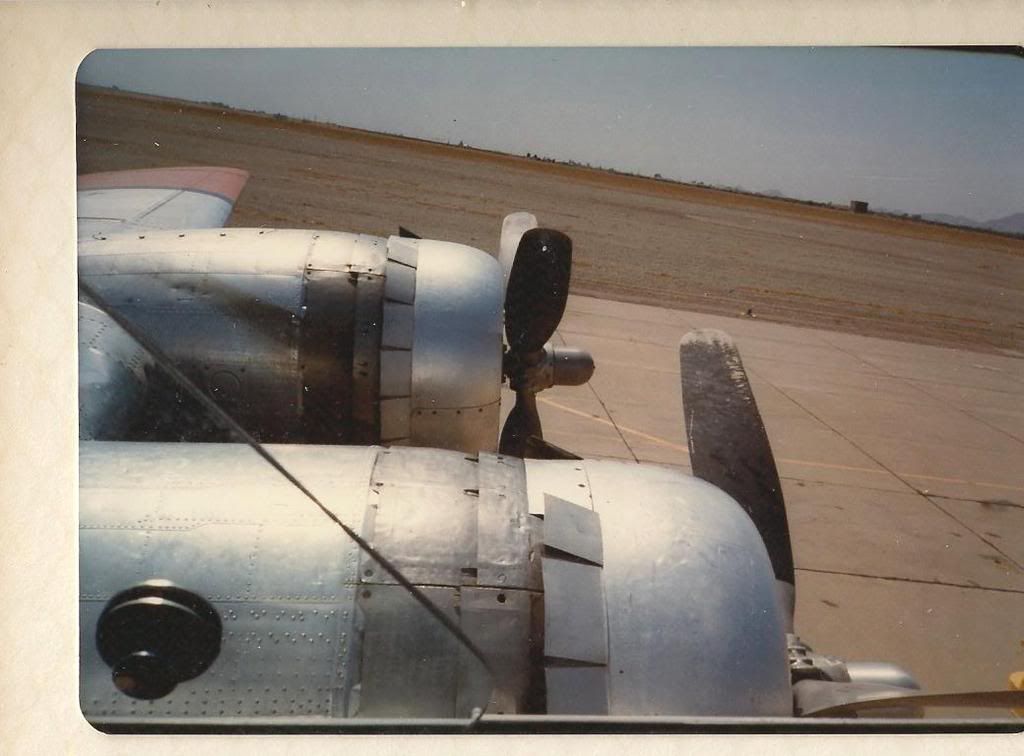
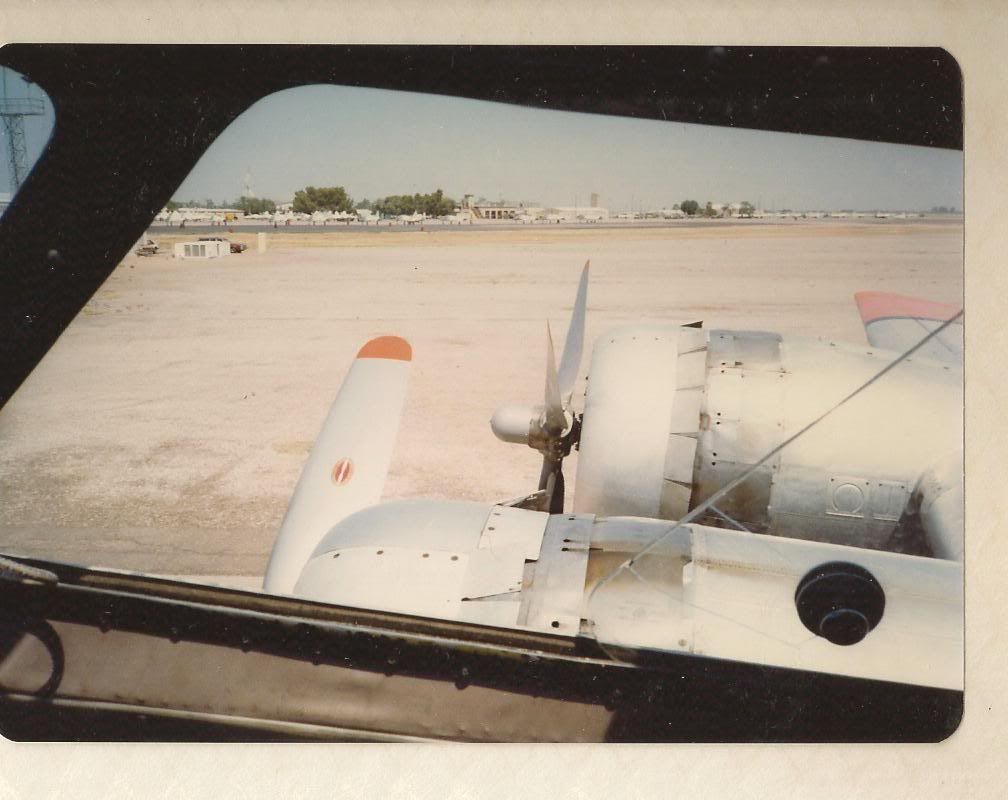
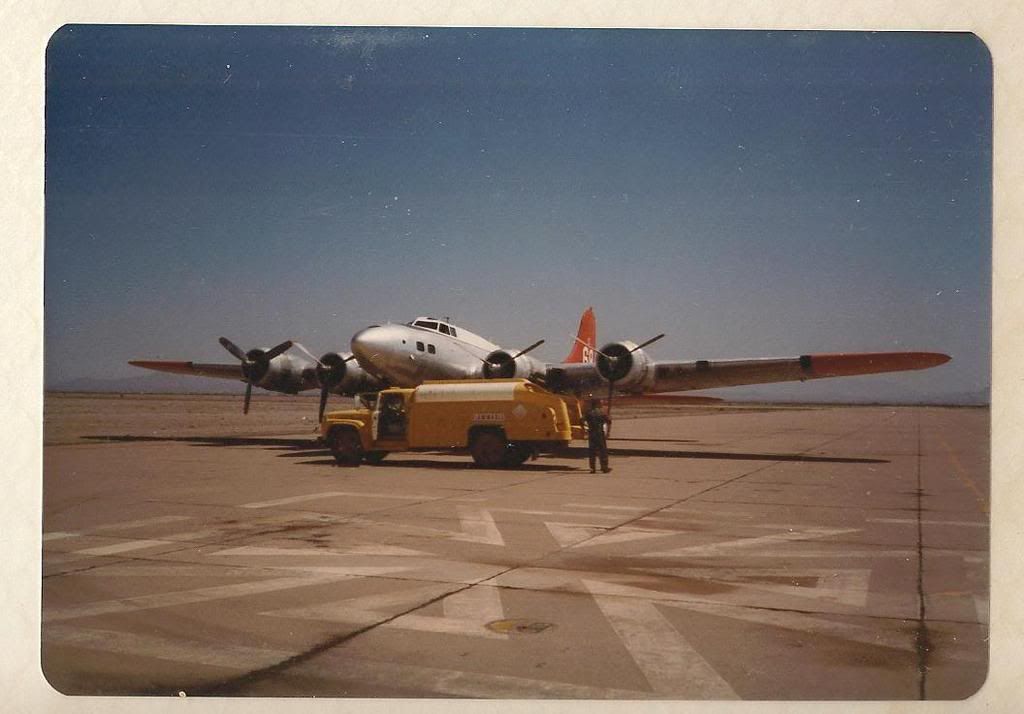
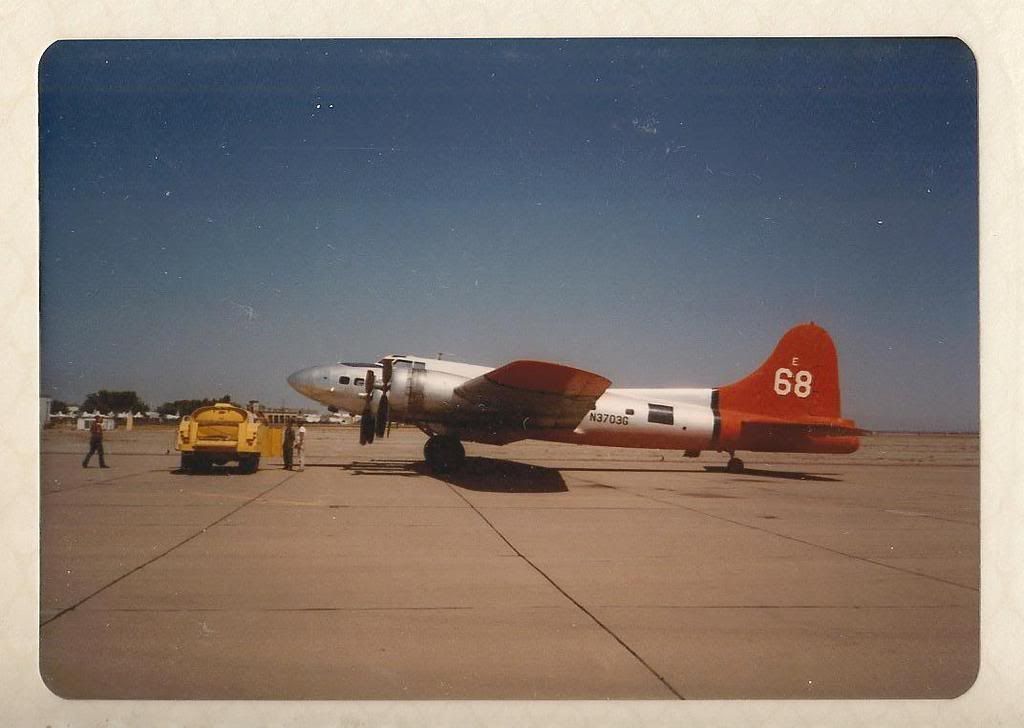
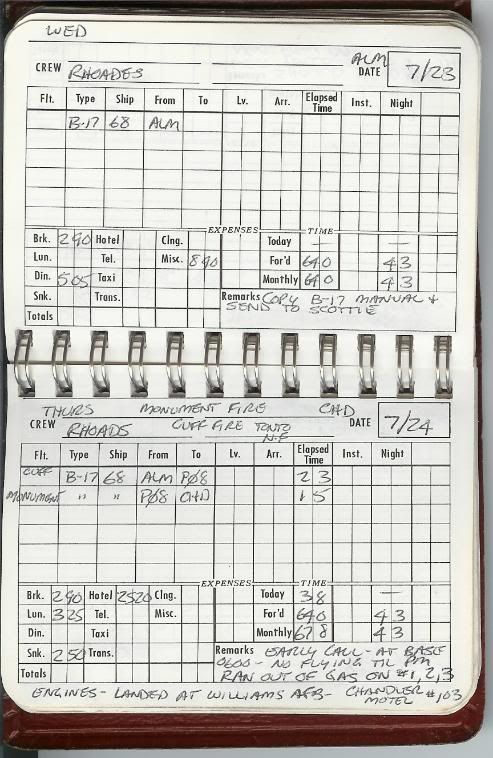







Sun Jan 13, 2008 9:20 pm
Jeeeeez!!! That must have been a real wing and a prayer experience! Please tell us more... some of the readers here might find it useful. I know I would be interested to hear the story. Thanks for posting the photos... does this B-17 still exist?
Cheers,
Richard
Cheers,
Richard
Sun Jan 13, 2008 9:35 pm
RMAllnutt wrote:does this B-17 still exist?
MILITARY AIRCRAFT RESTORATION CORP
http://registry.faa.gov/aircraftinquiry ... rtxt=3703G
http://www.warbirdregistry.org/b17regis ... 83546.html
My 1980 Single Engine B-17 Landing
Sun Jan 13, 2008 9:42 pm
Richard,that airplane went to Dave Tallichet and is now The Memphis Belle aka N3703G.I'll work on a narrative and post it in a day or two.Basically,I was dispatched from my home base at Alamogordo to a fire by Roosevelt Lake north of Phoenix.After dropping on the fire,I went to the nearest tanker base at Coolidge to fuel and reload.There were several other tankers (P2V's,PB4Y's and another B-17) waiting for the fuel truck ahead of me.I was asked if I'd initial attack a new fire 20 miles from Coolidge.I stuck the tanks and the lowest was 105 gallons and I had 75 gals in each Tokyo tank.Against my better judgement,I reluctantly accepted the dispatch.
Sun Jan 13, 2008 11:01 pm
WOW!
Yikes...How much fuel did you have left in #4??
Great story, great pics and I'm guessing it was a well learned lesson?
Yikes...How much fuel did you have left in #4??
Great story, great pics and I'm guessing it was a well learned lesson?
My 1980 Single Engine B-17 Landing
Mon Jan 14, 2008 2:39 pm
The short answer to how much fuel left in #4 would be "Fumes".I still had 300 gallons in the Tokyo tanks that wouldn't go where I needed it.I'll give the details in a while.I definitely learned several valuable lessons that day.More on that later.In the meantime,here are a few pictures of Tanker 68 in Alamogordo (a garden spot).The pictures are as follows:
1.Alamogordo,NM (ALM) Airport looking east
2.Tanker 68 on the day off parking area at ALM
3.Tanker 68 in the ALM loading pit looking south
4.Oiling #1 engine on Tanker 68 at ALM
5&6.Cockpit shots of Tanker 68 on the ground at ALM
7&8.Tanker 68 at loaded cruise power (31"/2100 RPM) with my co-pilot Bill Rhodes at the controls on the way to a fire from ALM
All of these pictures were taken sometime between April and July 1980
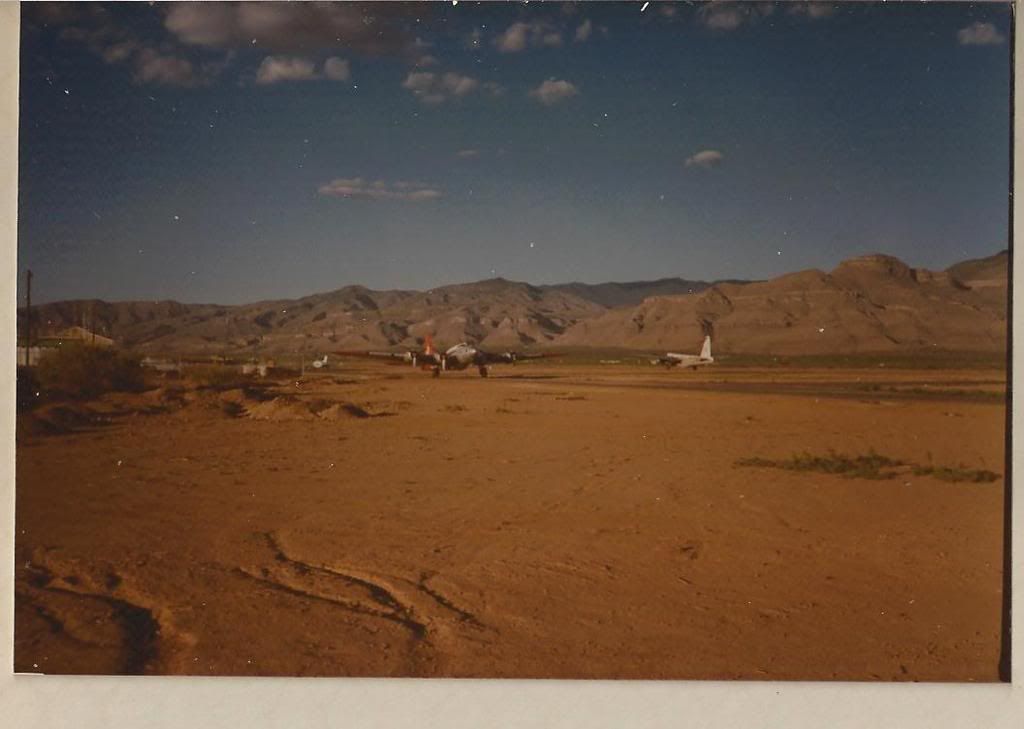
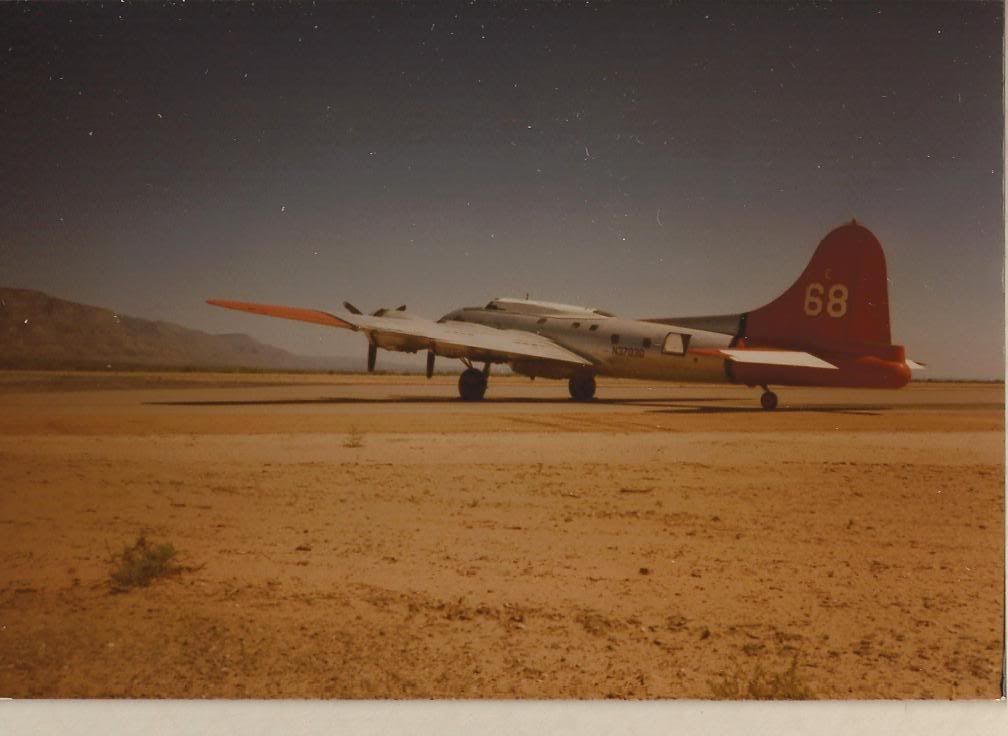
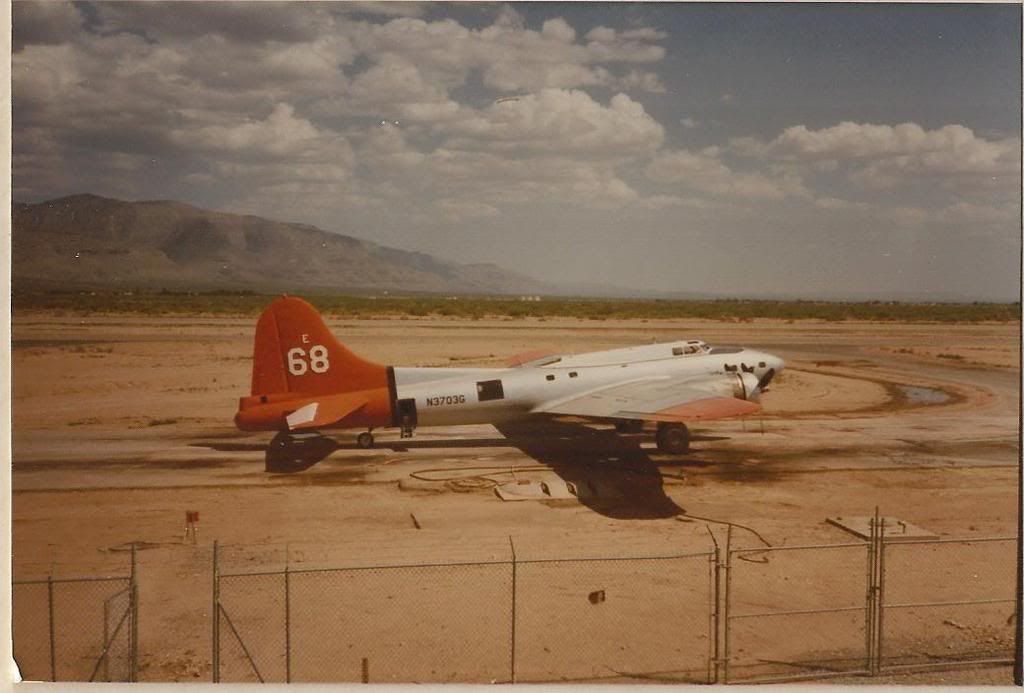
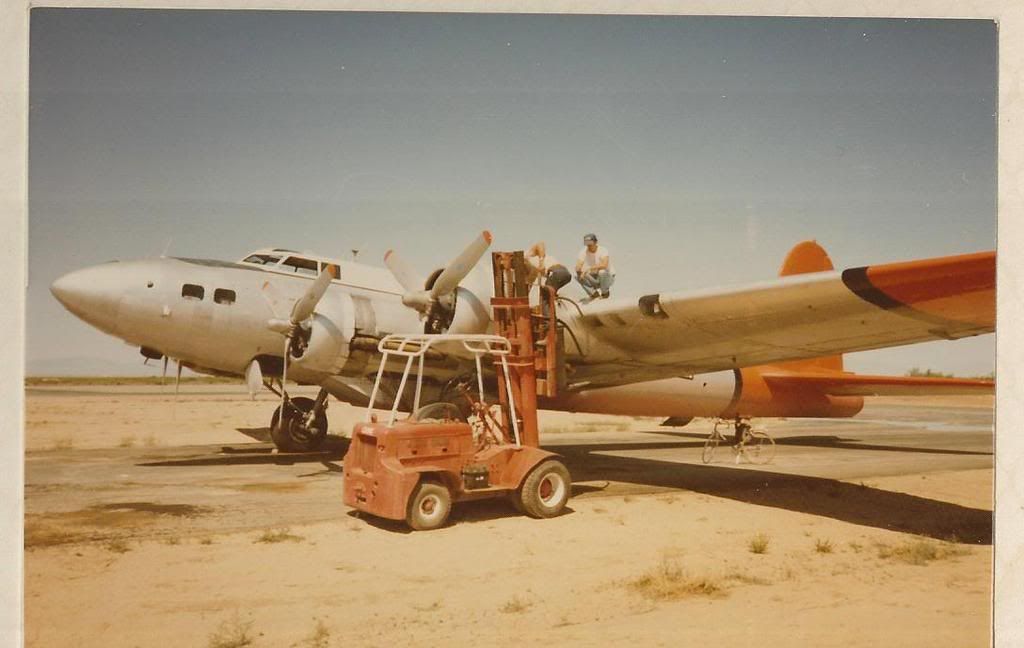
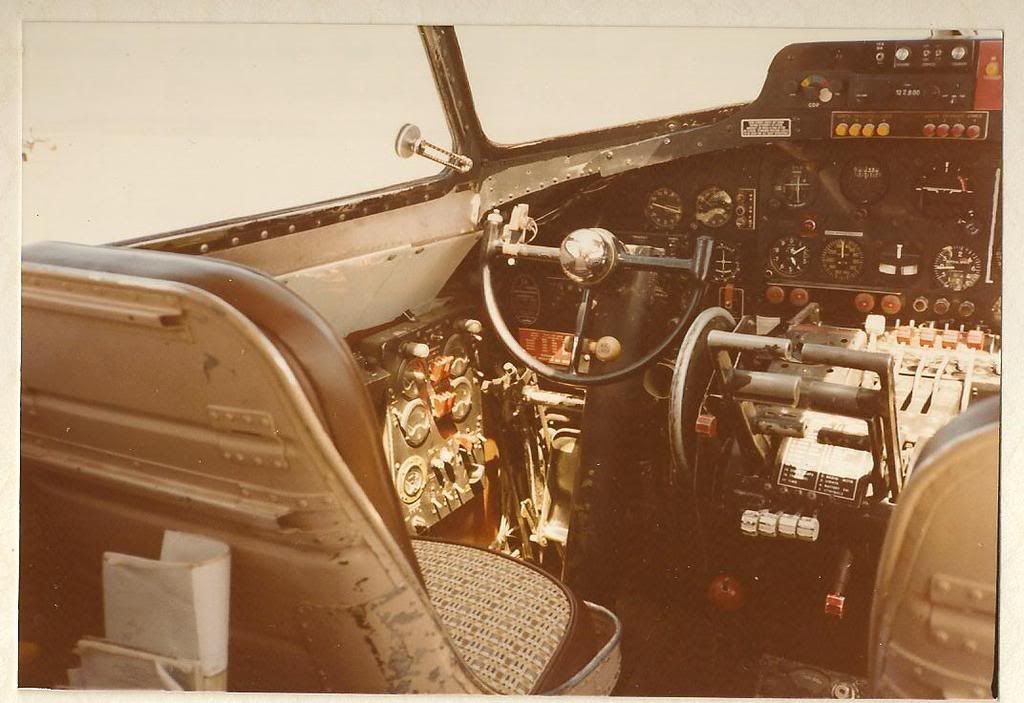
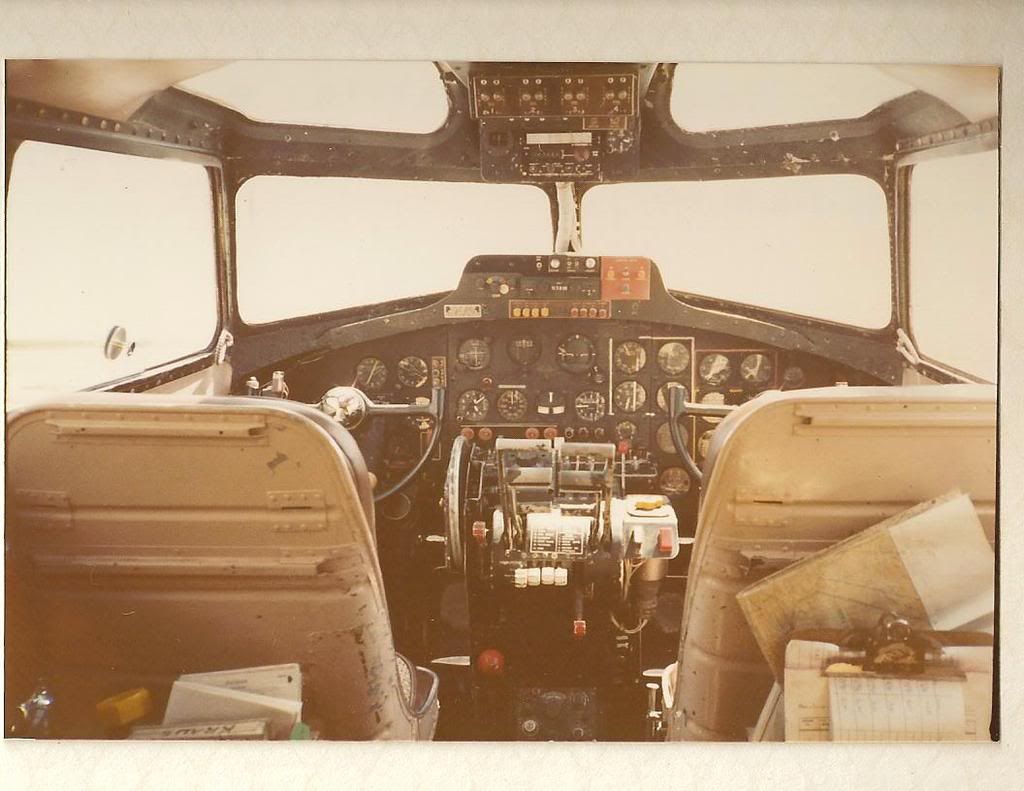
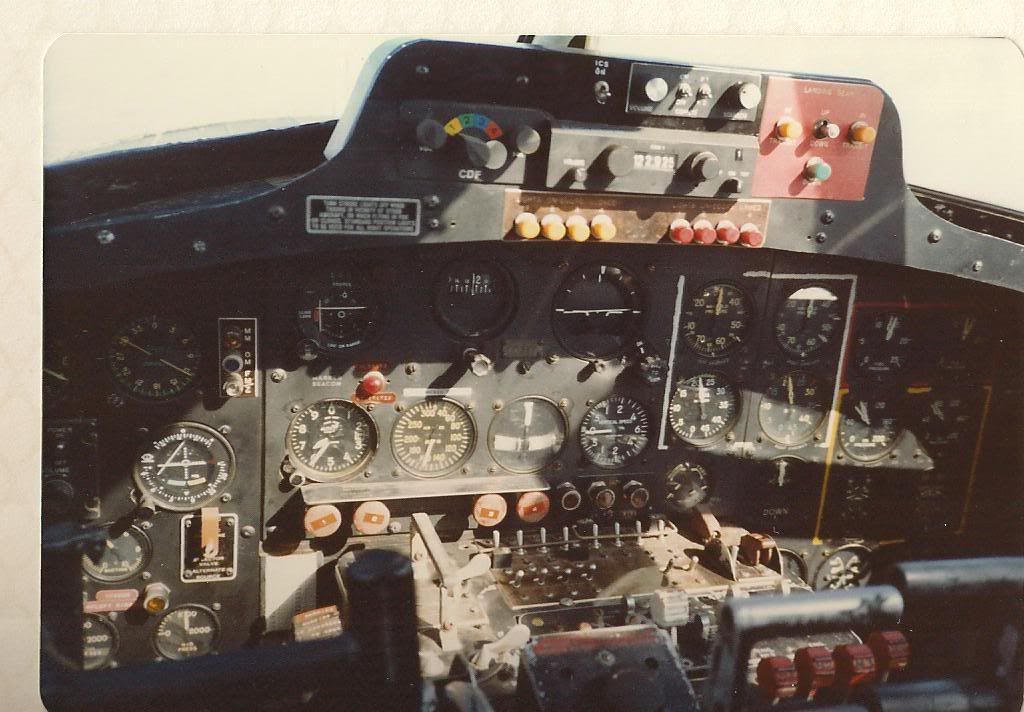
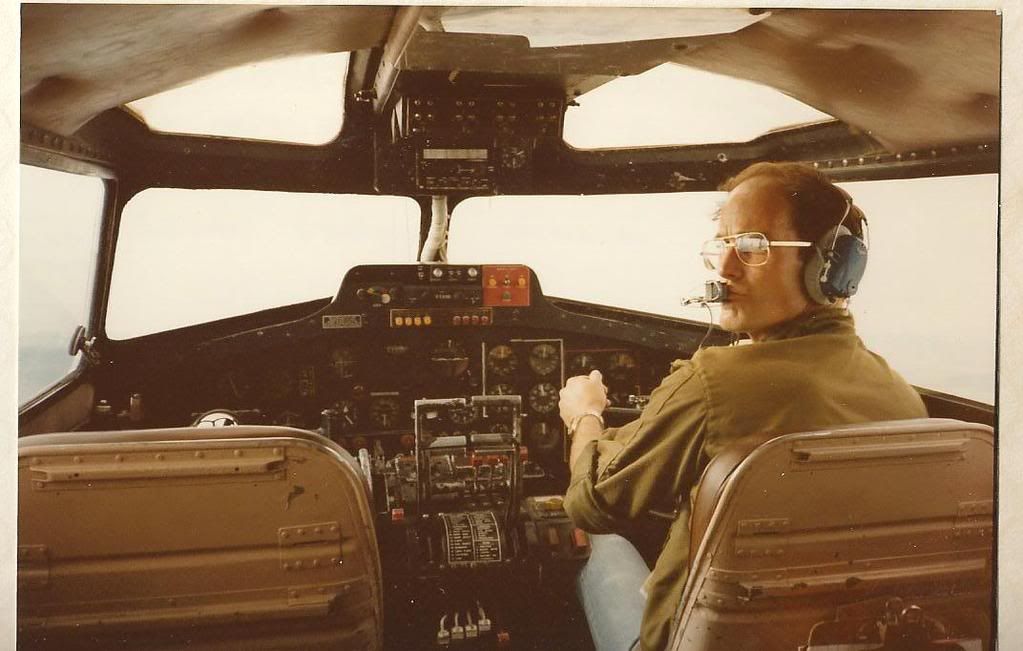
1.Alamogordo,NM (ALM) Airport looking east
2.Tanker 68 on the day off parking area at ALM
3.Tanker 68 in the ALM loading pit looking south
4.Oiling #1 engine on Tanker 68 at ALM
5&6.Cockpit shots of Tanker 68 on the ground at ALM
7&8.Tanker 68 at loaded cruise power (31"/2100 RPM) with my co-pilot Bill Rhodes at the controls on the way to a fire from ALM
All of these pictures were taken sometime between April and July 1980








Mon Jan 14, 2008 2:44 pm
Cool pictures, Larry. But you've got us waiting in suspense for the "rest of the story." Come on man...let's hear it! 
Gary
Gary
Mon Jan 14, 2008 3:04 pm
He said he ran out of gas.... What else do you need to know? 
Mon Jan 14, 2008 3:36 pm
Larry;
Did you ever make it to Hemet in 1980? My dad was flying C-119's for HVFS during that time, I can remember seeing three or four B-17's flying out of there on a big fire up at Big Bear, not to mention the DC-4s, and PB4Y-2's, and S-2's I think Larry Hill use fly 68 before going to work HVFS flying C-119's. If I remember correctly he used to fly 81 for HVFS, my dad would have been in 86 that year or maybe 87.
Scott......
Did you ever make it to Hemet in 1980? My dad was flying C-119's for HVFS during that time, I can remember seeing three or four B-17's flying out of there on a big fire up at Big Bear, not to mention the DC-4s, and PB4Y-2's, and S-2's I think Larry Hill use fly 68 before going to work HVFS flying C-119's. If I remember correctly he used to fly 81 for HVFS, my dad would have been in 86 that year or maybe 87.
Scott......
Mon Jan 14, 2008 4:22 pm
bdk wrote:He said he ran out of gas.... What else do you need to know?
Good point.
I reckon I wonder how sore his right leg was after having to hold the rudder pedal after flying with only the #4 engine running. Must've been an interesting landing as well.
Gary
Mon Jan 14, 2008 5:14 pm
bdk wrote:He said he ran out of gas.... What else do you need to know?
He did not run out of gas, someone filled the tanks with the wrong type of gas, instead of 100LL, they were filled with air by a unknowing lineman............................................................................last time I checked, air was a gas
Mon Jan 14, 2008 6:11 pm
Guess it helps to memorize the zero thrust power setting, huh?retroaviation wrote:Must've been an interesting landing as well.
My 1980 Single Engine B-17 Landing
Mon Jan 14, 2008 8:14 pm
Okay,I ran out of usable fuel and to this day can't explain why I didn't have at least 40 minutes fuel left in the mains,but I did learn several lessons.For instance,just because the systems on one B-17 work in a particular way,don't count on the all working that way.Also,there are important bits of information in maintenance manuals that aren't in the flight manuals.I already knew not to put much faith in fuel gauges,but I thought that at least one of them might be remotely accurate.
As I mentioned earlier,I was dispatched from Alamogordo to a fire north of Phoenix and ended up in Coolidge to refuel and reload.The lowest reading in the main tanks,according to our dipstick,was 105 gallons.The others ranged between 110 and 120 gallons.We used to use,as a rule of thumb for the B-17,a gallon per minute per engine and throw in 10 gallons for the climb.Tanker 68 had been having erratic fuel consumption all fire season.Three engines would have normal (expected) fuel consumption and one would burn up to 25% more.Also,it varied on which engine burned more fuel.
The fire that I was supposed to inital attack was less than 20 miles from Coolidge and I should be able to get there,size up the situation,drop and be back in 40 minutes,tops.The first problem was that there were thunderstorms moving through the area,which is why fires were starting.The ringer being that the thunderstorms,which had been dry,were turning wet.Just as I got to the fire,a heavy shower moved over it and put it out.I had to call dispatch and get a divert to another new start.Of course,it was a little farther out than the first one.Navigation in those days before GPS,or even Loran took more time with just a radial and distance from a tanker base or VOR (that you couldn't recieve because of terrain or altitude).Also,in a B-17,you go around terrain instead of over it,especially on short trips.
By the time I got to the second fire,it was washed away as well.So,I ended up going back to the original fire by Roosevelt Lake.The lead plane had gone in for fuel,but the air attack was there.It only took a few minutes to figure out the plan,which was to drop one door at a time on hot spots.The B-17 had 4 retardant tank compartments,each one with a door.I made three drops and the lead plane came back to the fire and decided to have me hold off dropping the last door until he made a few passes.He finally decided that the run that he'd called me off of was as good as any,but I should follow him.
So,we were on final behind the leadplane with throttled back to about 20" when Bill Rhodes (my co-pilot) said that he thought that #2 just quit.I know that sounds like an odd statement,but,with the power below barometric,it's hard to tell that an engine,especially an inboard,has died.The RPM doesn't change and the manifold pressure will follow the others on throttle changes as long as you stay below barometric.The only way that he knew was because we suddenly had zero fuel pressure on #2.I made the drop and headed out of the area toward Coolidge trying to figure out what was going on.We were only 40 minutes into the flight,so we should still have plenty of fuel.
The first thing that we did was to open the valve for the Tokyo tank on #2.There was 75 gallons of fuel in that tank.This might be a good time to describe the fuel system on a B-17,which is unique,to say the least.For one thing,there are no fuel selectors (only an electic shutoff valve on the firewall) and there is no cross-feed.You can transfer fuel across the airplane with an electric pump at 12 1/2 gallons per minute,but you can't use fuel from #1 engine in #2 without first transferring it to #3 or #4 and back to #2.Also,you can't run multiple engines off of a single fuel tank.The bottom line being that the transfer system works,but takes time.Even so,when #2 didn't immediately refire,I considered transferring some fuel from #3 to it.
Each engine has 425 gallons available with the mains topped.The outboards are easy with one self sealing 425 gal tank.With the inboards there's a problem because of the main landing gear being in the way of where the turbo is mounted in the outboards.So,the inboard turbo had to be moved aft and there wasn't room for a large enough fuel tank.The solution being an interconnected 212 and 213 gallon tanks.That brought up the capacity,but created problems in accurately sticking the inboard tanks (among other things).
Part way through production of the B-17F series,Tokyo tanks were introduced.These were interconnected self sealing tanks that were squeezed between the wing ribs outboard of the outboard engines.They got progressively smaller as they got closer to the wingtip.As a result,to add up to an additional 270 gallons per engine,the inboards had 4 interconnected tanks and the outboards had 5.These are like the wing tanks on a Cub.There are no boost pumps in the Tokyos,or fuel gauges,for that matter.All that you can do it wait for the main tanks to get down to around 100 gals and open the valve to the Tokyo tank.Originally,these were manually operated from the radio room.Ours had rotary electric valves.
I'd flown in Tanker 65,another B-17G (actually a PB-1W) for 4 years prior to the 1980 season.We routinely carried only 50 gals in each Tokyo tank and had occassionally drained it into the mains with no problem,other than it taking a little while because of the lack of head pressure in the Tokyos.I'd tested the Tokyo tanks in Fresno before heading for Alamogordo by adding 150 gals to each and opening the Tokyo tank valves.Thre was less than 100 gals in each main at the time.They fed a little unevenly,but all of the fuel transferred to the mains withing about 10-15 minutes.
Back to my story.Since #2 didn't restart,rather than transfer fuel across the wing,I had another plan.I feathered #2 once we were out of sight of the leadplane and air attack.We tried the #2 main boost pump every minute or two to see if we'd get fuel pressure,but decided that we'd be okay,except for figuring out why #2 apparently had no fuel available.Since you taxi a B-17 on the outboards and all that we had to do was climb another 1500 feet and we'd be 10 minutes from Coolidge,I'd unfeather #2 when we got within sight of the airport and nobody would ever know that it wasn't running.
That plan went to Hell when the #1 fuel pressure gauge fluctuated a couple of times and went to zero.The lowest main fuel gauge showed 40 gallons remaining.We opened all of the Tokyo tank valves and called the air attack to let him know that we had what appeared to be a fuel starvation situation.Then we called Phoenix Approach and decared an emergecy.The first thing that the controller did was to give me a vector for Coolidge.I couldn't go that direction because of terrain.The next closest airport was Falcon Field,which was about 4000 ft long,uncontrolled and usually had a pattern full of Cessna 150's.Since this was probably going to be a one shot approach/landing,we opted for Williams AFB (now Williams Gateway).They had three 10,000 ft runways and crash and rescue available.
We got pointed in the right direction and I had a little time to think.My first thought was "This can't be happening to me! I checked the fuel and there's plenty of gas in the Tokyo tanks".I was watching the terrain,which was rolling desert with sand,rocks and lots of cactus plants.There was a resonably straight dirt road going close to the same direction that we were,except that it seemed to have a steel cattle guard with posts at the edges about every 1500 ft.I tried to figure out how I was going to dead stick the airplane onto the road and stop between the cattle guards.
The next thought was "How am I going to explain this to the boss?" I'd made a copy of the B-17 pilot's manual and sent it to my brother a few days before.I reread the manual while making the copy and it recommended a little less than 1/4 flap as being the best configuration for flying with multiple engines out.I tried it for 3-4 minutes and all that happened was a 50 fpm increase in our rate of descent.I went back to zero flaps.Not too long after that,#3 fuel pressure fluctuated a couple of times and #3 quit.We still couldn't get any fuel pressure on #2 or on #1.
I asked the controller how far we were from the end of the runway at Williams.He said that it was 12 nautical miles.We had 1500 ft of altitude above field elevation and at climb power on #4 were losing 200 fpm.I don't remember exactly,but I think that we were indicating about 120 mph.I could see the runway and Williams Tower had cleared the area of other traffic,so we were cleared to land on any runway in any direction.Wind wasn't an issue,but there was only one path to the end of the runway.
When we were about 5 miles out,I could see that we'd make it as long as #4 kept running.If not,there was what looked like an auto test track a mile or so short of the runway and off to the side.If all else failed,I'd try for that.As it turned out,we dropped the landing gear at a mile final and crossed the end of the runway with a couple of hundred feet of altitude to spare and #4 still running.It was the quietest landing that I've ever made in a B-17 when I closed the #4 throttle all that I could hear was the rush of the wind.
We turned off at mid-field and the tower told me to taxi to the base of the tower.I told him that if I could taxi to the base of the tower,I wouldn't have landed at Williams.It took a while to convince him that I couldn't just taxi on one engine,especially an outboard.They finally sent out a big fire truck and a few hundred feet of heavy rope and towed the airplane to the ramp.My co-pilot stayed with the airplane to ride the brakes while I went to Base Ops to start making phone calls and filling out paperwork.I filled out paperwork on that little incident for 3 years.Nobody from any agency tried to give me a hard time in any way.I mentioned my plan to land on the auto track to somebody in Base Ops.He said that it's a good thing that I didn't do that.It turns out that it's an auto torture track that's all speed bumps.Apparently,a Skyraider took off from Williams in the 60's and landed on that track when his engine barked a few times.By the time he stopped,all of the engine mounts had broken and the engine fell off from running over the speed bumps.
We spent the night at Williams while my boss (Hank Moore) made arrangements with Woody Grantham to bring 750 gals of 100/130 to Williams in his gas truck from Chandler.We fueled up,turned on the boost pumps and had fuel pressure all around.That day was supposed to be our scheduled day off.The Forest Service allowed us to ferry the airplane to Coolidge and still count it as a day off.This was mainly because Williams wanted us out of there asap.
When I got to Coolidge,Gary Packard was there in Evergreen's B-17 Tanker 22.I figured that my dipstick must be faulty,so I compared it to his.There wasn't 1/16 inch difference at any of the markings.My immediate solution to the problem was to carry the same amount of fuel (250 gpe) and flight plan for 45 minutes less than I had been.I also decided to figure that any fuel in the Tokyos was useless for anything except ballast.
Once I got back to Sequioa Field (TBM Inc's maintenance base).I found out a few things.First,there were 3 different manufacturers of B-17 self sealing main tanks and they varied in slightly in capacity.I checked the markings on the tanks in T65 and T68.It turned out that T65 had the largest tanks and T68 had the smallest.It made a difference of 15 gpe.This was in the B-17 Erection and Maintenance Manual,but there's no mention of it in the flight manual.When I spoke with Kenny Stubbs (TBM's Director of Maintenance),I learned the reason for the Tokyo tank fiasco.
T68 had a problem with the Tokyo tanks deteriorating internally and contaminating the fuel (to a very minor degree) with rubber flakes.The Forest Service mainternance inspector had made TBM install gascolators in the fuel supply lines between the Tokyo tanks and the mains.I knew about this because we sumped the gascolators while draining the main fuel sumps.Tanker 65 didn't have gascolators because it didn't have a problem with deterioration.The revalation from Kenny was "Didn't I tell you? You need to have 150 gals in the Tokyo tanks on T68 to get enough head pressure to get past the gascolators when the valve is opened."That, coincidentally,was exactly the amount that I randomly chose when I tested the Tokyo tanks for flow in Fresno.
As to where the rest of the fuel went from the mains? Your guess is as good as mine.One thing that happened a few years later (1983,I think) was that I happened to see Andy Anderson (who was the leadplane pilot from Wenatchee,WA) in a restaurant at Reno.He'd had a few drinks.I was leaving with Dave Kelly as we'd finished eating.Andy called me over and said that my running out of fuel/single engine landing was the best thing that I ever did because before that nobody knew that I existed and now everybody knew me.I suppose that it's nice to be known for something?!
As I mentioned earlier,I was dispatched from Alamogordo to a fire north of Phoenix and ended up in Coolidge to refuel and reload.The lowest reading in the main tanks,according to our dipstick,was 105 gallons.The others ranged between 110 and 120 gallons.We used to use,as a rule of thumb for the B-17,a gallon per minute per engine and throw in 10 gallons for the climb.Tanker 68 had been having erratic fuel consumption all fire season.Three engines would have normal (expected) fuel consumption and one would burn up to 25% more.Also,it varied on which engine burned more fuel.
The fire that I was supposed to inital attack was less than 20 miles from Coolidge and I should be able to get there,size up the situation,drop and be back in 40 minutes,tops.The first problem was that there were thunderstorms moving through the area,which is why fires were starting.The ringer being that the thunderstorms,which had been dry,were turning wet.Just as I got to the fire,a heavy shower moved over it and put it out.I had to call dispatch and get a divert to another new start.Of course,it was a little farther out than the first one.Navigation in those days before GPS,or even Loran took more time with just a radial and distance from a tanker base or VOR (that you couldn't recieve because of terrain or altitude).Also,in a B-17,you go around terrain instead of over it,especially on short trips.
By the time I got to the second fire,it was washed away as well.So,I ended up going back to the original fire by Roosevelt Lake.The lead plane had gone in for fuel,but the air attack was there.It only took a few minutes to figure out the plan,which was to drop one door at a time on hot spots.The B-17 had 4 retardant tank compartments,each one with a door.I made three drops and the lead plane came back to the fire and decided to have me hold off dropping the last door until he made a few passes.He finally decided that the run that he'd called me off of was as good as any,but I should follow him.
So,we were on final behind the leadplane with throttled back to about 20" when Bill Rhodes (my co-pilot) said that he thought that #2 just quit.I know that sounds like an odd statement,but,with the power below barometric,it's hard to tell that an engine,especially an inboard,has died.The RPM doesn't change and the manifold pressure will follow the others on throttle changes as long as you stay below barometric.The only way that he knew was because we suddenly had zero fuel pressure on #2.I made the drop and headed out of the area toward Coolidge trying to figure out what was going on.We were only 40 minutes into the flight,so we should still have plenty of fuel.
The first thing that we did was to open the valve for the Tokyo tank on #2.There was 75 gallons of fuel in that tank.This might be a good time to describe the fuel system on a B-17,which is unique,to say the least.For one thing,there are no fuel selectors (only an electic shutoff valve on the firewall) and there is no cross-feed.You can transfer fuel across the airplane with an electric pump at 12 1/2 gallons per minute,but you can't use fuel from #1 engine in #2 without first transferring it to #3 or #4 and back to #2.Also,you can't run multiple engines off of a single fuel tank.The bottom line being that the transfer system works,but takes time.Even so,when #2 didn't immediately refire,I considered transferring some fuel from #3 to it.
Each engine has 425 gallons available with the mains topped.The outboards are easy with one self sealing 425 gal tank.With the inboards there's a problem because of the main landing gear being in the way of where the turbo is mounted in the outboards.So,the inboard turbo had to be moved aft and there wasn't room for a large enough fuel tank.The solution being an interconnected 212 and 213 gallon tanks.That brought up the capacity,but created problems in accurately sticking the inboard tanks (among other things).
Part way through production of the B-17F series,Tokyo tanks were introduced.These were interconnected self sealing tanks that were squeezed between the wing ribs outboard of the outboard engines.They got progressively smaller as they got closer to the wingtip.As a result,to add up to an additional 270 gallons per engine,the inboards had 4 interconnected tanks and the outboards had 5.These are like the wing tanks on a Cub.There are no boost pumps in the Tokyos,or fuel gauges,for that matter.All that you can do it wait for the main tanks to get down to around 100 gals and open the valve to the Tokyo tank.Originally,these were manually operated from the radio room.Ours had rotary electric valves.
I'd flown in Tanker 65,another B-17G (actually a PB-1W) for 4 years prior to the 1980 season.We routinely carried only 50 gals in each Tokyo tank and had occassionally drained it into the mains with no problem,other than it taking a little while because of the lack of head pressure in the Tokyos.I'd tested the Tokyo tanks in Fresno before heading for Alamogordo by adding 150 gals to each and opening the Tokyo tank valves.Thre was less than 100 gals in each main at the time.They fed a little unevenly,but all of the fuel transferred to the mains withing about 10-15 minutes.
Back to my story.Since #2 didn't restart,rather than transfer fuel across the wing,I had another plan.I feathered #2 once we were out of sight of the leadplane and air attack.We tried the #2 main boost pump every minute or two to see if we'd get fuel pressure,but decided that we'd be okay,except for figuring out why #2 apparently had no fuel available.Since you taxi a B-17 on the outboards and all that we had to do was climb another 1500 feet and we'd be 10 minutes from Coolidge,I'd unfeather #2 when we got within sight of the airport and nobody would ever know that it wasn't running.
That plan went to Hell when the #1 fuel pressure gauge fluctuated a couple of times and went to zero.The lowest main fuel gauge showed 40 gallons remaining.We opened all of the Tokyo tank valves and called the air attack to let him know that we had what appeared to be a fuel starvation situation.Then we called Phoenix Approach and decared an emergecy.The first thing that the controller did was to give me a vector for Coolidge.I couldn't go that direction because of terrain.The next closest airport was Falcon Field,which was about 4000 ft long,uncontrolled and usually had a pattern full of Cessna 150's.Since this was probably going to be a one shot approach/landing,we opted for Williams AFB (now Williams Gateway).They had three 10,000 ft runways and crash and rescue available.
We got pointed in the right direction and I had a little time to think.My first thought was "This can't be happening to me! I checked the fuel and there's plenty of gas in the Tokyo tanks".I was watching the terrain,which was rolling desert with sand,rocks and lots of cactus plants.There was a resonably straight dirt road going close to the same direction that we were,except that it seemed to have a steel cattle guard with posts at the edges about every 1500 ft.I tried to figure out how I was going to dead stick the airplane onto the road and stop between the cattle guards.
The next thought was "How am I going to explain this to the boss?" I'd made a copy of the B-17 pilot's manual and sent it to my brother a few days before.I reread the manual while making the copy and it recommended a little less than 1/4 flap as being the best configuration for flying with multiple engines out.I tried it for 3-4 minutes and all that happened was a 50 fpm increase in our rate of descent.I went back to zero flaps.Not too long after that,#3 fuel pressure fluctuated a couple of times and #3 quit.We still couldn't get any fuel pressure on #2 or on #1.
I asked the controller how far we were from the end of the runway at Williams.He said that it was 12 nautical miles.We had 1500 ft of altitude above field elevation and at climb power on #4 were losing 200 fpm.I don't remember exactly,but I think that we were indicating about 120 mph.I could see the runway and Williams Tower had cleared the area of other traffic,so we were cleared to land on any runway in any direction.Wind wasn't an issue,but there was only one path to the end of the runway.
When we were about 5 miles out,I could see that we'd make it as long as #4 kept running.If not,there was what looked like an auto test track a mile or so short of the runway and off to the side.If all else failed,I'd try for that.As it turned out,we dropped the landing gear at a mile final and crossed the end of the runway with a couple of hundred feet of altitude to spare and #4 still running.It was the quietest landing that I've ever made in a B-17 when I closed the #4 throttle all that I could hear was the rush of the wind.
We turned off at mid-field and the tower told me to taxi to the base of the tower.I told him that if I could taxi to the base of the tower,I wouldn't have landed at Williams.It took a while to convince him that I couldn't just taxi on one engine,especially an outboard.They finally sent out a big fire truck and a few hundred feet of heavy rope and towed the airplane to the ramp.My co-pilot stayed with the airplane to ride the brakes while I went to Base Ops to start making phone calls and filling out paperwork.I filled out paperwork on that little incident for 3 years.Nobody from any agency tried to give me a hard time in any way.I mentioned my plan to land on the auto track to somebody in Base Ops.He said that it's a good thing that I didn't do that.It turns out that it's an auto torture track that's all speed bumps.Apparently,a Skyraider took off from Williams in the 60's and landed on that track when his engine barked a few times.By the time he stopped,all of the engine mounts had broken and the engine fell off from running over the speed bumps.
We spent the night at Williams while my boss (Hank Moore) made arrangements with Woody Grantham to bring 750 gals of 100/130 to Williams in his gas truck from Chandler.We fueled up,turned on the boost pumps and had fuel pressure all around.That day was supposed to be our scheduled day off.The Forest Service allowed us to ferry the airplane to Coolidge and still count it as a day off.This was mainly because Williams wanted us out of there asap.
When I got to Coolidge,Gary Packard was there in Evergreen's B-17 Tanker 22.I figured that my dipstick must be faulty,so I compared it to his.There wasn't 1/16 inch difference at any of the markings.My immediate solution to the problem was to carry the same amount of fuel (250 gpe) and flight plan for 45 minutes less than I had been.I also decided to figure that any fuel in the Tokyos was useless for anything except ballast.
Once I got back to Sequioa Field (TBM Inc's maintenance base).I found out a few things.First,there were 3 different manufacturers of B-17 self sealing main tanks and they varied in slightly in capacity.I checked the markings on the tanks in T65 and T68.It turned out that T65 had the largest tanks and T68 had the smallest.It made a difference of 15 gpe.This was in the B-17 Erection and Maintenance Manual,but there's no mention of it in the flight manual.When I spoke with Kenny Stubbs (TBM's Director of Maintenance),I learned the reason for the Tokyo tank fiasco.
T68 had a problem with the Tokyo tanks deteriorating internally and contaminating the fuel (to a very minor degree) with rubber flakes.The Forest Service mainternance inspector had made TBM install gascolators in the fuel supply lines between the Tokyo tanks and the mains.I knew about this because we sumped the gascolators while draining the main fuel sumps.Tanker 65 didn't have gascolators because it didn't have a problem with deterioration.The revalation from Kenny was "Didn't I tell you? You need to have 150 gals in the Tokyo tanks on T68 to get enough head pressure to get past the gascolators when the valve is opened."That, coincidentally,was exactly the amount that I randomly chose when I tested the Tokyo tanks for flow in Fresno.
As to where the rest of the fuel went from the mains? Your guess is as good as mine.One thing that happened a few years later (1983,I think) was that I happened to see Andy Anderson (who was the leadplane pilot from Wenatchee,WA) in a restaurant at Reno.He'd had a few drinks.I was leaving with Dave Kelly as we'd finished eating.Andy called me over and said that my running out of fuel/single engine landing was the best thing that I ever did because before that nobody knew that I existed and now everybody knew me.I suppose that it's nice to be known for something?!
Last edited by Larry Kraus on Sun Jan 20, 2008 11:40 am, edited 2 times in total.
Mon Jan 14, 2008 9:23 pm
that is a great story! Thanks for sharing it.
B
B
Mon Jan 14, 2008 9:27 pm
Wow. Talk about "pucker time". Glad to see that you and the Fortress made it through okay.
It does go to show you that a good aircraft design is almost timeless. The Fortress did what its designers wanted it to do: Accomplish its mission and bring its crew home safely. The fact that it was doing this on a mission never imagined when the 17 was on the drawing boards in 1935 is a testament to the people that designed the machine.
I'm sure if you told the Boeing designers that Fortresses would still be flying in the year 2008 they'd look at you as if you were nuts.
It does go to show you that a good aircraft design is almost timeless. The Fortress did what its designers wanted it to do: Accomplish its mission and bring its crew home safely. The fact that it was doing this on a mission never imagined when the 17 was on the drawing boards in 1935 is a testament to the people that designed the machine.
I'm sure if you told the Boeing designers that Fortresses would still be flying in the year 2008 they'd look at you as if you were nuts.